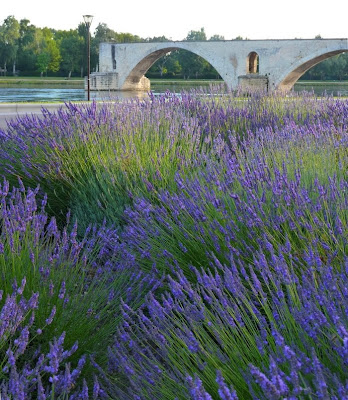Provence has been inhabited since prehistoric times. Paleolithic sites dating to 900,000 B.C. have been discovered along the Cote d’Azur.
The Rhone River, on the western border of Provence, is one of the major rivers of France, and has been a highway of commerce and communications between inland France and the Mediterranean for centuries.
Most of Provence has a Mediterranean climate characterized by hot, dry summers, mild winters, little snow, and lots of sunshine. Within Provence there are micro-climates and local variations (something we Bay Area folks are quite familiar with).
Historically the language spoken in Provence was Provençal, a dialect of the Occitan language, also known as Langue d’oc, and closely related to Catalan. Today the main language is French.
Artists have been painting in Provence since prehistoric times; paintings of bisons, seals, penguins and horses dating to between 27,000 and 19,000 b.c. were found in the Cosquer Cave near Marseille.
In the 19th and 20th centuries, many of the most famous painters in the world were drawn to the Provence region. The climate and the clarity of the light were the primary reasons. Provence has a special quality of light, which is partly due to the Mistral wind, which removes dust from the atmosphere and greatly increases visibility.
**The mistral is a strong, cold and usually dry regional wind in France, coming from the north or northwest, which accelerates when it passes through the valleys of the Rhone and the Durance Rivers to the coast of the Mediterranean around the Camarque region.
The Mistral helps explain the unusually sunny climate (2700 to 2900 hours of sunshine a year) and clarity of the air of Provence
The mistral has the reputation of bringing good health, since the dry air dries stagnant water and the mud, giving the mistral the local name mange-fange (Eng. "mud-eater"). It also blows away pollution from the skies over the large cities and industrial areas.
Famous Painters of Provence
Paul Cezanne, was born in Aix-en-Provence, and lived and worked there most of his life. The local landscapes were often in his work.
Vincent van Gogh only lived about two years in Provence, but his fame as a painter is largely a result of what he painted there.
Auguste Renoir visited several cities in the region before finally settling in Cagnes-sur-Mer, where he bought a farm in the hills and built a new house and workshop on the grounds. He continued to paint there until his death in 1919. His house is now a museum.
Henri Matisse first visited St Tropez in 1904. In 1917 he settled in Nice, He then moved to the Hotel Regina in the hills of Cimiez, above Nice. During World War II he lived in Vence ( Vence, "City of Art", is a lovely town sitting in the fresh air of the hills only a few km from Nice and Antibes. The town is full of flowers and, in the area around the town, aromatic flowers, olives and colorful orange trees are cultivated)
then returned to Cimiez, where he died and is buried.
Pablo Picasso spent each summer from 1919 to 1939 on the Côte d'Azur, and moved there permanently in 1946
where he spent his last years.
The world renowned wines of Provence are said to have been introduced into Provence around 600 B.C. by the Greek Phoceans who also founded Marseille and Nice. The great majority of the wines produced in Provence are rosés. The most characteristic grape is mourvedre, used most famously in the red wines of Bandol. Cassis is the only area in Provence known for its white wines.
I'm Just Sayin








No comments:
Post a Comment